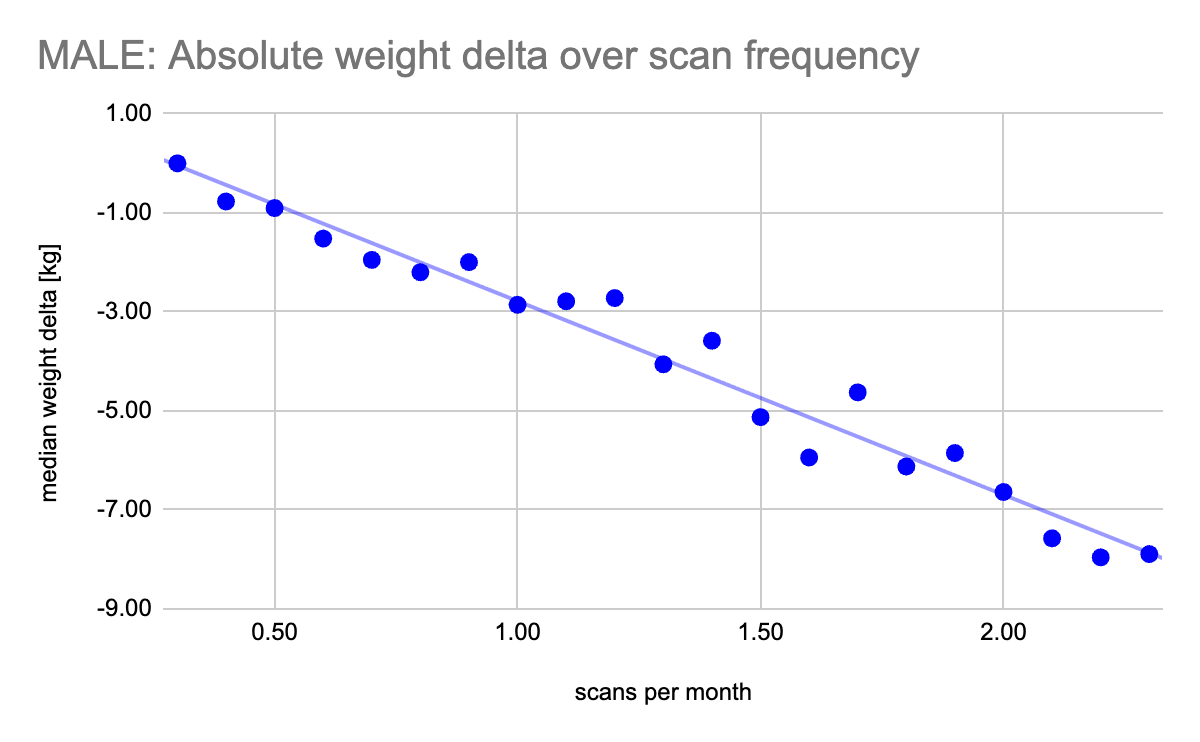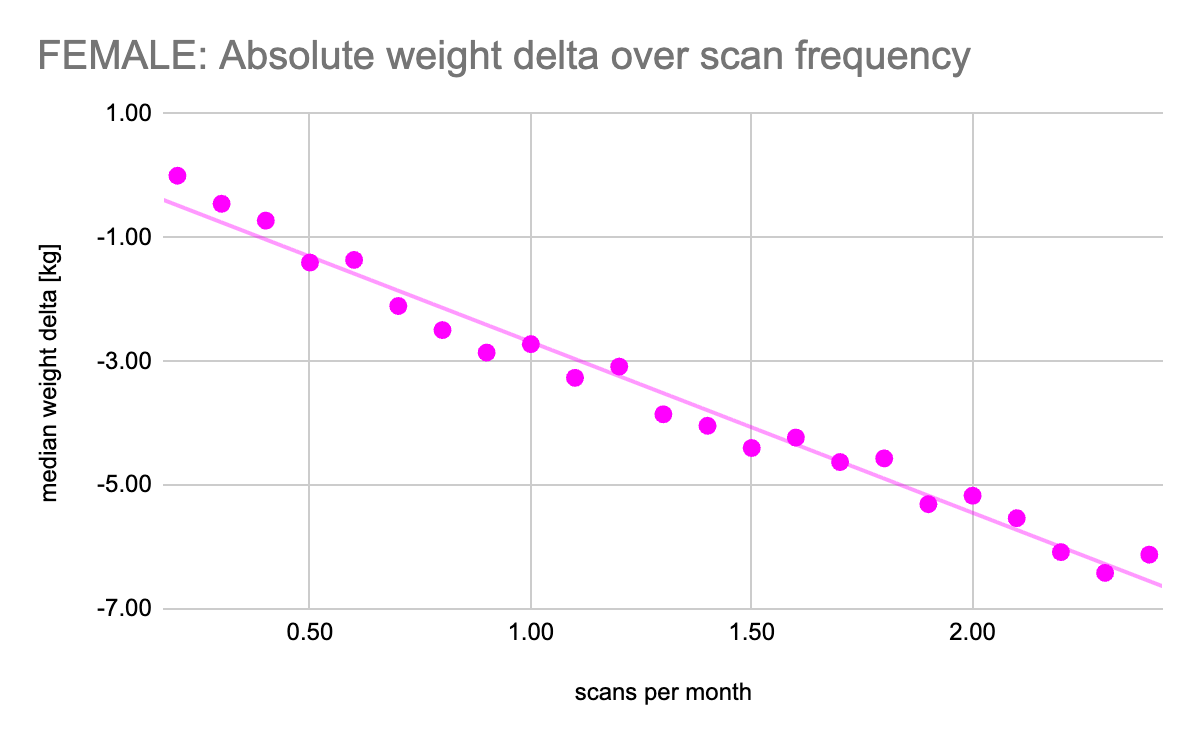Case Study: How Scan Frequency Drives Weightloss Success
The evidence is clear. More frequent scanning comes with greater metabolic health outcomes
.png)
New research reveals the surprising link between user engagement and actual health outcomes—and it's reshaping how digital health platforms measure success.
We've always known that engaged users get better results, but proving it has been elusive—until now. Our comprehensive analysis of 600,000 production scans from 17,000 users who scanned over four months or more has uncovered a game-changing finding: scan frequency directly predicts weight loss success. The more often users scan, the more weight they lose—and this linear relationship holds true across both men and women.
This isn't just another engagement metric. The data definitively connect user behavior with measurable health outcomes, providing a powerful new way for weight loss, fitness, and healthcare applications to think about engagement optimization.
Scan Frequency vs Weight Loss: Strong Linear Correlation for Both Genders


The Data are Clear
Our analysis focused on users who engaged with body scanning technology over at least four months. We measured scan frequency—the number of scans per month—against median weight changes from first to last scan, using only measurements taken at least 24 hours apart to ensure data integrity.
The results were striking: a clear linear correlation between scanning frequency and weight loss outcomes. Users scanning once per month averaged minimal weight changes, while those scanning 4-5 times monthly achieved significantly greater weight loss. This pattern remained consistent regardless of gender, creating a reliable framework for predicting user success based on engagement behavior.
We may ask, do people who lose more weight scan more, or does the frequency scanning help them lose weight? What makes this finding revolutionary is that it validates what behavioral psychologists have long theorized: frequent self-monitoring creates a feedback loop that drives behavioral change. When users regularly track their progress through body composition scanning, they maintain awareness of their goals, make course corrections, and stay motivated through visible progress indicators.
Why Traditional Engagement Metrics Fall Short
Most digital health platforms rely on standard engagement metrics—daily active users, session duration, feature usage rates. These metrics tell you if users are present, but not if they're succeeding. Our scan frequency data bridges this gap by connecting engagement directly to outcomes.
Research consistently shows that self-monitoring frequency is the strongest predictor of weight loss success. Studies demonstrate that participants monitoring their progress 5-6 days per week lose significantly more weight than those with sporadic tracking patterns. Our data extends this principle to body scanning: frequent scanners don't just use the platform more—they achieve better results.
This creates what we call "meaningful engagement"—interactions that correlate directly with desired health outcomes rather than simple platform activity. For digital health companies, this distinction is crucial because it transforms engagement from a retention metric into a success predictor.
The Business Case for Scan Frequency Optimization
For weight loss applications, fitness platforms, and healthcare providers, scan frequency data offers unprecedented strategic advantages:
Predictive Customer Success
Traditional customer success metrics are reactive—you learn about problems after users have already struggled or churned. Scan frequency is predictive. When scanning patterns decline, you can identify at-risk users before they fail and deploy targeted interventions to restore engagement and outcomes.
Personalized Intervention Triggers
Our linear correlation data enables precision engagement strategies. Users scanning less than 2-3 times monthly can be automatically enrolled in re-engagement campaigns, coaching touchpoints, or motivational content designed to restore success-driving frequency levels. This personalization improves both user outcomes and platform metrics.
Outcome-Based Differentiation
While competitors focus on generic engagement metrics, platforms leveraging scan frequency can demonstrate actual outcome correlation. This provides compelling differentiation when courting enterprise clients, insurance partnerships, or outcome-based reimbursement opportunities.
Revenue Optimization Through Results
The connection between scan frequency and weight loss creates a direct link between engagement and customer value realization. Users who scan frequently achieve better results, making them more likely to continue subscriptions, upgrade to premium features, and generate positive reviews and referrals.
Beyond Weight Loss: Universal Applications
While our study focused on weight loss outcomes, the scan frequency principle extends across health applications:
Exercise and Fitness Platforms can use scanning frequency to optimize workout program effectiveness. Users who regularly scan show measurable changes in body composition, validating training programs and maintaining motivation during progress plateaus.
Healthcare Applications can leverage scan frequency for remote patient monitoring and treatment optimization. Regular body composition tracking provides objective data for chronic disease management, medication effectiveness assessment, and preventive care interventions.
Corporate Wellness Programs can implement scan frequency as an engagement metric that correlates with actual health improvements, supporting ROI calculations and program optimization for maximum employee benefit.
The Competitive Advantage of Outcome-Correlated Engagement
Our scan frequency research provides digital health platforms with a unique competitive positioning opportunity. Unlike generic engagement metrics that every platform can measure, scan frequency offers outcome correlation that few can deliver.
This differentiation becomes crucial when competing for:
- Enterprise clients seeking evidence-based engagement solutions
- Healthcare partnerships requiring clinical outcome validation
- Insurance reimbursements demanding measurable health improvements
- User acquisition in markets demanding proven effectiveness
Looking Forward: From Engagement to Outcomes
The discovery of scan frequency's correlation with weight loss success represents a fundamental shift in digital health platform optimization. We're moving beyond measuring activity toward measuring impact—from tracking usage to predicting outcomes.
This evolution empowers platforms to focus their development and marketing efforts on features and strategies that drive real user success. When engagement metrics directly correlate with health improvements, every optimization becomes both a business improvement and a contribution to user well-being.
The future belongs to platforms that can prove their impact. Our scan frequency data provides the foundation for this proof, transforming body scanning from a feature into a strategic advantage that drives both user outcomes and business results.
For digital health platforms ready to move beyond vanity metrics toward outcome-driven engagement, scan frequency represents the next evolution in user success prediction and optimization.
